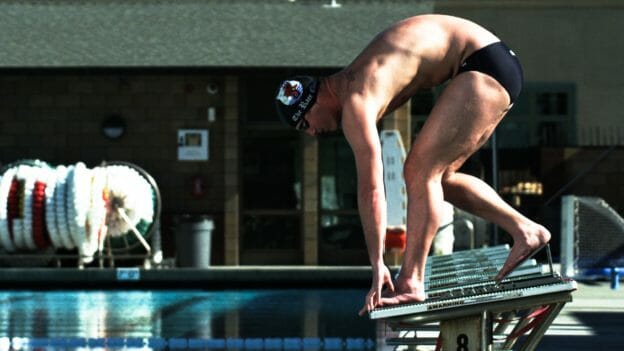The Track Start
Nearly all swimmers today use a track start with one foot forward and the other back on the starting block. With the introduction of the back wedge on the top of the block in 2009, virtually all swimmers adopted the track start. Regardless of the type of start used, the favorable angle of the back wedge increases the potential force from the feet using the track start. The only swimmers that I do not recommend using the track start are older Masters swimmers that have trouble with balance and equilibrium. They are better off with both feet forward on the edge of the block.
There are two distinctly different types of track start, weight forward and weight back (or slingshot). With the weight forward start, the majority of the swimmer’s weight is placed on the front foot with the toes wrapped over the edge of the block. With the weight back start, at the command of ‘take your mark’, the swimmer shifts the majority of the body weight to the back foot by leaning backward a few degrees. In watching the Olympic Games in Rio, there appear to be a significant number of swimmers using both types of track start, weight forward and backward. Here are the advantages and disadvantages of each type.
Weight Forward
Advantages
- Faster reaction time to get off the block quicker
- Enables fast dolphin kickers to get in the water sooner
Disadvantage
- Less propulsive force generated with nearly all force derived from front foot
Weight Back
Advantages
- Potential for more propulsion from arms, back and front foot
- May increase the coupling energy from the arm motion
Disadvantage
- Slower reaction time to get off the block
With the weight forward start, most of the propulsion is coming from the front foot and since the weight is positioned further forward, it is the fastest way to leave the block. The center of the body’s mass is positioned directly over the hands which are either pulling upward on the front of the block or the bars on the top of the block. From that position, it is impossible to generate any meaningful propulsion from the arms. It is the front foot (leg) doing most of the propulsion, with some coming from the back foot.
With the weight back start, it is important that the body does not shift backward too far, which would require too much time for the swimmer to leave the block. Only a few degrees of motion are needed to shift the majority of weight to the back foot. From that position, with the center of mass behind the hands, one can generate some propulsion from the arms, with the hands wrapped around the front of the block or on the bars above the block, by pulling the body forward. The propulsion begins with the arms and the back foot simultaneously, then shifts to the front foot as the body moves forward. With the weight back start, there are three potential sources of propulsion, back foot, front foot and arms (hands), while with the weight forward start, the front foot does most of the work.
What’s Correct for You?
Deciding which track start to use is not easy. The outcome of either start, however, should not be judged by the reaction time to leave the block, but rather where the swimmer breaks out from under the water. This is influenced by the time required to leave the block, the propulsive force leaving the block (vertical leap ability), the frontal drag caused from arms, body, legs and feet upon the water entry, the mass (weight) of the swimmer, the speed of the underwater dolphin kick and the frontal drag and transitional speed at breakout.
In general, the weight forward start may be preferred by swimmers with exceptionally fast dolphin kicks, as it will enable the swimmer to enter the water sooner. The weight-back start is often preferred by swimmers that have strong upper bodies and arms, and with a bigger vertical leap (more fast twitch muscles). In order to overcome the disadvantage of the delay in leaving the block with the weight-back start, one must take advantage of using the forces from the arms and both feet.
The question of which foot goes forward is controversial. I have found that most swimmers prefer to place the dominant foot forward. Yet I have also seen some excellent swimmers that did the opposite. What is most important is that the swimmer feels comfortable in the selected position of the feet and that it results in the best start.
Use Your Head, Arms and Legs
Regardless of which track start is used, weight forward or backward, both dives should incorporate the three coupling motions to augment the swimmer’s propulsive forces leaving the block. The three coupling motions of the start are the head lift, the arm motion and the upward kick of the rear leg. The amount of kinetic energy in those three motions can have a huge impact on the effectiveness of the dive. In the next article, we will discuss those three important coupling motions.
Yours in swimming,
Gary Sr.
Read Improving Your Start from the Block – Part II: Coupling Motions, The Head
Read Improving Your Start from the Block – Part III: Coupling Motions, The Arm Recovery
Read Improving Your Start from the Block – Part IV: Coupling Motions, The Leg Motion
Read Improving Your Start from the Block – Part V: Five Techniques to a Great Start

